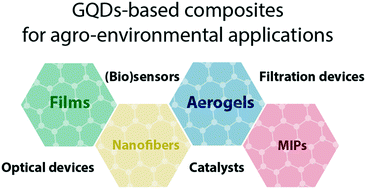A review on graphene quantum dots and their nanocomposites: from laboratory synthesis towards agricultural and environmental applications
Abstract
Graphene quantum dots (GQDs) are 0D materials belonging to the carbon-based family that present some interesting characteristics of graphene combined with a tunable bandgap emerging from their reduced size, which gives them final outstanding physical–chemical properties. Furthermore, GQDs can be combined with other materials to produce nanocomposites with remarkable properties and superior performance. In this review, we present a timely survey on how the structural characteristics and physical–chemical properties of GQDs enable their use in advanced composite materials for agricultural and environmental applications. Specifically, emphasis is given to GQD-based composites in the form of films, nanofibers, aerogels, and molecularly imprinted polymers. The unique properties of GQD nanocomposites are suitable for designing devices employed in: i) filtration membranes and adsorbent materials for contaminant removal; ii) optical devices and (bio)sensors with different transduction modes for detecting hazardous analytes including pesticides, heavy metals, antibiotics, and food contaminants; iii) and novel catalyst systems for degrading pollutants. Finally, current challenges and future prospects on industrial applications of GQD-based composites are also discussed.

- This article is part of the themed collection: Environmental Remediation


 Please wait while we load your content...
Please wait while we load your content...